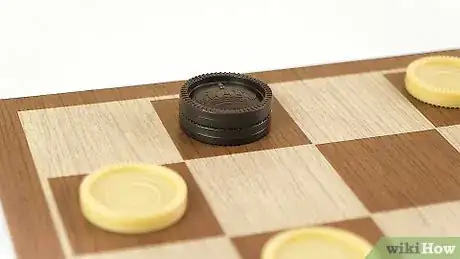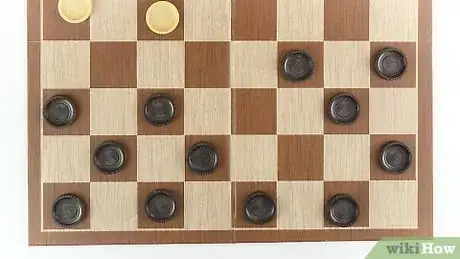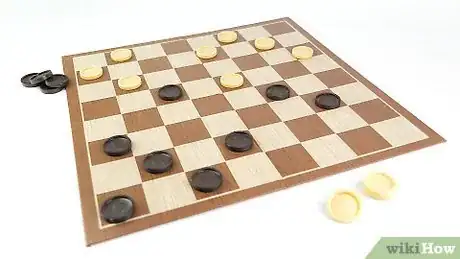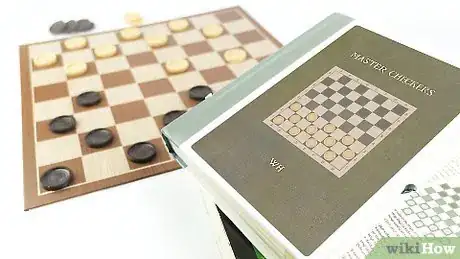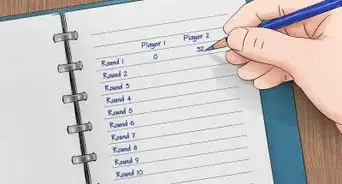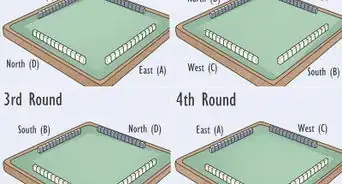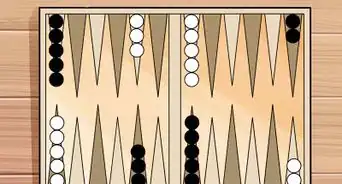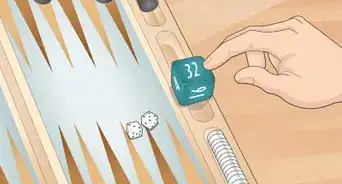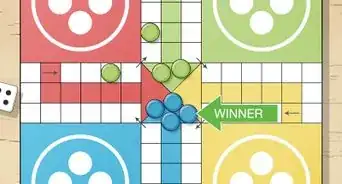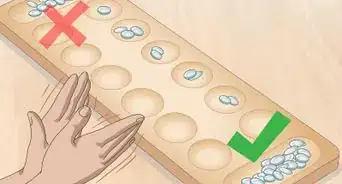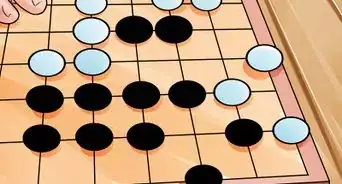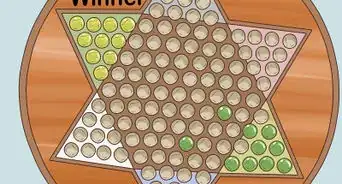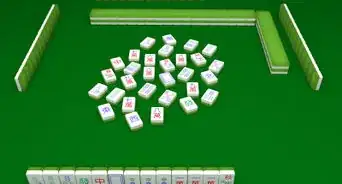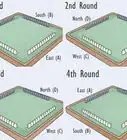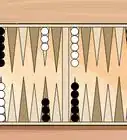wikiHow is a “wiki,” similar to Wikipedia, which means that many of our articles are co-written by multiple authors. To create this article, 22 people, some anonymous, worked to edit and improve it over time.
There are 8 references cited in this article, which can be found at the bottom of the page.
The wikiHow Video Team also followed the article's instructions and verified that they work.
This article has been viewed 841,975 times.
Learn more...
Ready to start beating your family and friends at checkers? Learn the fundamentals of checkers and you'll have a big advantage over amateur players. If you're ready to take your game to the next level, there are some specific strategies that can help to improve your chances of winning. You may also want to consider getting into tournament play or working with an expert to improve your game.
Steps
Improving Your Chances of Winning
-
1Focus on crowning more pieces than your opponent. In checkers, the person who has more kings also has the advantage. Try to crown as many pieces as possible to increase your chances of winning the game.[1]
- To put this advice into practice, advance a piece toward an area on your board where your opponent has fewer pieces, or pieces that are more spread out. If you can protect this piece with nearby pieces and sacrifices, then you have a good chance at making a king.
- See Intermediate Strategies below for how to "redirect the enemy" and sneak through a king.
-
2Keep your back row in place until you need to move those checkers. It's impossible for your opponent to crown his or her pieces if your back row is occupied, so this strategy will prevent your opponent from getting the advantage too soon in the game. You will also have more movement options left when you do start moving your back row pieces.[2]
- Remember that you won't be able to keep your back row intact forever. Once you're low on pieces or you see an opportunity for an advantageous trade, don't hesitate to move out.
Advertisement -
3Advance pieces in close groups and in tandem. Two pieces "in tandem" are adjacent to each other on a diagonal line. Keeping pieces near enough to form tandem in one move makes it much harder for your opponent to capture them.[3] [4]
- "Following" a piece you moved earlier before you move it again will leave your front piece less open to capture. Following it with two pieces is even safer, since you can block capture from two directions.
- See Intermediate Strategies to learn how to form "trapping pairs".
-
4Trade checkers when you're ahead. It's obvious that trading one of your checkers for two of your opponent's checkers benefits you, but even trading one for one is useful if you had more checkers to begin with.[5]
- For example, if you have 5 checkers and your opponent has 4 checkers, then the board is almost equal. But once you trade three pieces each, you have a huge advantage with twice as many pieces as your opponent.
-
5Control the center of the board. If you keep a few pieces near the center, you will keep your options open and be able to move rapidly to whichever side of the board needs your attention. Likewise, preventing your opponent from placing pieces in the center will deny him or her this advantage.[6]
- It takes practice to judge how many pieces you need to commit to the center in a particular game. As a general rule, you should try to build up enough of a position that the opponent is unable to safely advance anywhere except the left and right edges. After that goal is achieved, adding more of your pieces can actually clog up your board and lower your options.
Using Strategies to Capture Checkers
-
1Sacrifice pieces to gain advantages. The "forced capture" rule requires a player to make a capture if they are able to. Think ahead to what the board will look like if you force your opponent to capture your piece and you might discover it's worth the sacrifice.
- If you're trying to crown a piece but your opponent is pursuing it, you can sacrifice a less important piece to lure the pursuer away from your soon-to-be king.[7]
- If you have a diagonal line of pieces, moving the forward one toward the enemy can force a capture that places the enemy piece next to another of yours. Make sure you don't open yourself up to a double capture![8]
-
2Try a "Trapping Pairs" strategy. To use the "Trapping Pairs" strategy, you need to wait for a certain setup on the board. Your first checker (piece 1) should be in the leftmost or rightmost column, against the edge of the board. Your second checker (piece 2) should be one row in front of your first checker on the diagonal. Following that same diagonal, there should be an empty space, then one of your opponent's checkers(piece A), then another opponent checker (piece B) one row behind.[9]
- Move piece 2 toward your opponent's pieces, so that it is in danger of being captured.
- The forced capture rule requires your opponent's piece A to jump piece 2, but it cannot then jump piece 1 because it is against the edge of the board.
- After your opponent has captured your piece 2, the you can use your piece 1 to jump piece A.
- In the basic scenario described, this is an unexciting 1-for-1 trade. However, after setting up your trapping pair, you can often wait to "trigger" it until the opportunity for a double capture arises.
-
3Use the "Redirect Your Enemy" strategy. To use "Redirect Your Enemy," you will need to designate 6 pieces on one side of your board as group A and the other 6 on the other side as group B. You will use these designations to determine what pieces you move at different times in the game.[10]
- Move the pieces in A group almost exclusively at the start of the game, only occasionally moving a B piece when there is no good A move.
- When you begin trading pieces with your opponent, trade A pieces over B pieces whenever possible.
- Once a few capture exchanges have happened, your opponent will likely be concentrated on the side of the board with your A pieces. Begin advancing your B pieces in groups and you'll be in a strong position to crown past your opponent's depleted defenses.
Preparing for Tournament Play
-
1Decide which rules of checkers to follow. Some tournaments are run using basic checkers rules, referred to as Go As You Please, GAYP, or freestyle. Others follow the 3-move rules, which limit players' options at the start of the game to a set of three move sequences. (The 3-move rules greatly reduce the possibility of a draw between skilled players.)
-
2Study a checkers strategy guide that matches your rules system and skill level. More recent books will contain up-to-date strategic advances, but this is less important if you're a beginner. Browsing the checkers shelf at a library or bookstore can help you find a book that is helpful and fun to read.
-
3Practice and memorize specific opening sequences. For 3-move play, find an encyclopedia of 3-move openers. For GAYP rules, select a preferred opener and practice games with every possible response from your opponent.[11]
- Memorizing specific board states from the mid-game and endgame can be useful as well, but you're much less likely to encounter a specific midgame in a tournament than one of the standard openers.
-
4Play against the best opponents you can find. Playing against more experienced players who are willing to share their knowledge is a great way to improve your game. Whether that means entering tournaments or finding your local amateur expert, the better your opponents are, the more you'll learn.[12]
Community Q&A
-
QuestionHow do I beat a person if they don't move their back row?
 Community AnswerJust force them to move their back row by forced capture or by mandatory move because there are no other available moves.
Community AnswerJust force them to move their back row by forced capture or by mandatory move because there are no other available moves. -
QuestionCan normal pieces kill the long?
 Community AnswerIf the question is can the "men" capture a "king," yes!
Community AnswerIf the question is can the "men" capture a "king," yes! -
QuestionHow do I avoid mandatory moves in checkers?
 Community AnswerBy thinking ahead and not moving to a position that will create a mandatory move on your next turn. However, you can't avoid mandatory moved entirely, nor should you want to, since they are the only way to capture your opponent's pieces and ultimately win.
Community AnswerBy thinking ahead and not moving to a position that will create a mandatory move on your next turn. However, you can't avoid mandatory moved entirely, nor should you want to, since they are the only way to capture your opponent's pieces and ultimately win.
Warnings
- Don't advance a single piece alone if you have other pieces to back it up. Early in the game, when you have plenty of pieces, you should always use them to protect each other.⧼thumbs_response⧽
- Don't play quickly. Especially when they see an opportunity to capture an opposing piece, a new player is eager to rush ahead and take that advantage. When playing against a more experienced player, this often means walking into their trap.⧼thumbs_response⧽
- Don't play too defensively. The "forced capture" rule will eventually require you to leave your defensive position. Trying to crown your own pieces is more effective than preventing your opponent doing so at your own expense.[13]⧼thumbs_response⧽
References
- ↑ http://www.checkers-strategy.com/getting-more-pieces-crowned.html
- ↑ http://boardgames.about.com/od/checkersdraughts/a/How-to-Win-at-Checkers.htm
- ↑ http://www.checkers-strategy.com/the-tandem-defense-offense.html
- ↑ http://boardgames.about.com/od/checkersdraughts/a/How-to-Win-at-Checkers.htm
- ↑ http://boardgames.about.com/od/checkersdraughts/a/How-to-Win-at-Checkers.htm
- ↑ http://www.usacheckers.com/excerpt-oldbury.php
- ↑ http://www.checkers-strategy.com/checkers-sacrifice-and-escape.html
- ↑ http://www.checkers-strategy.com/using-trapping-pair-forced.html
- ↑ http://www.checkers-strategy.com/using-trapping-pair-forced.html
About This Article
One strategy that can help you win at checkers is keeping your back row in place for as long as you can. That will make it impossible for your opponent to crown one of their pieces early on in the game. Focus on crowning more pieces than your opponent, which will give you a competitive edge. One way to crown more pieces is to play exclusively on the left or right side of the board so your opponent moves a lot of their pieces to that side. Then, advance your pieces on the other half of the board to your opponent’s side through the opening you’ve created. Another strategy you can try is moving your pieces forward in close groups so they’re harder to capture. When you move one piece, move another piece adjacent to it diagonally on your next turn. Always try to control the center of the board during a game, which will keep your options open and prevent your opponent from gaining the upper hand. Don't forget to keep an eye out for opportunities to double-jump your opponent too, which will help you capture more of their pieces faster. For strategies on how to capture your opponent’s checkers, keep reading!
